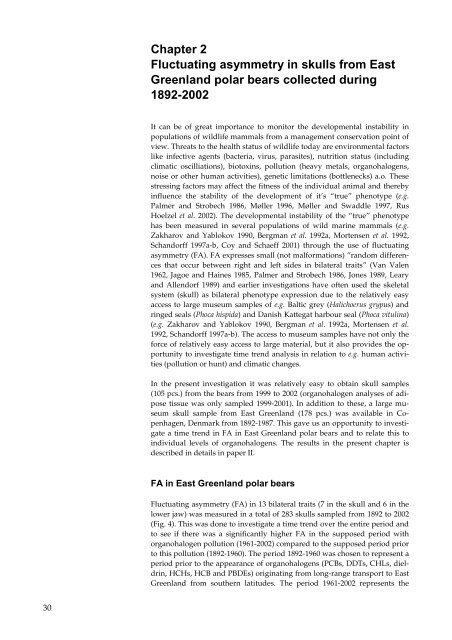Organohalogen concentrations and a gross and histologic ...
Organohalogen concentrations and a gross and histologic ...
Organohalogen concentrations and a gross and histologic ...
Create successful ePaper yourself
Turn your PDF publications into a flip-book with our unique Google optimized e-Paper software.
30<br />
Chapter 2<br />
Fluctuating asymmetry in skulls from East<br />
Greenl<strong>and</strong> polar bears collected during<br />
1892-2002<br />
It can be of great importance to monitor the developmental instability in<br />
populations of wildlife mammals from a management conservation point of<br />
view. Threats to the health status of wildlife today are environmental factors<br />
like infective agents (bacteria, virus, parasites), nutrition status (including<br />
climatic oscilliations), biotoxins, pollution (heavy metals, organohalogens,<br />
noise or other human activities), genetic limitations (bottlenecks) a.o. These<br />
stressing factors may affect the fitness of the individual animal <strong>and</strong> thereby<br />
influence the stability of the development of it’s “true” phenotype (e.g.<br />
Palmer <strong>and</strong> Strobech 1986, Møller 1996, Møller <strong>and</strong> Swaddle 1997, Rus<br />
Hoelzel et al. 2002). The developmental instability of the “true” phenotype<br />
has been measured in several populations of wild marine mammals (e.g.<br />
Zakharov <strong>and</strong> Yablokov 1990, Bergman et al. 1992a, Mortensen et al. 1992,<br />
Sch<strong>and</strong>orff 1997a-b, Coy <strong>and</strong> Schaeff 2001) through the use of fluctuating<br />
asymmetry (FA). FA expresses small (not malformations) ”r<strong>and</strong>om differences<br />
that occur between right <strong>and</strong> left sides in bilateral traits” (Van Valen<br />
1962, Jagoe <strong>and</strong> Haines 1985, Palmer <strong>and</strong> Strobech 1986, Jones 1989, Leary<br />
<strong>and</strong> Allendorf 1989) <strong>and</strong> earlier investigations have often used the skeletal<br />
system (skull) as bilateral phenotype expression due to the relatively easy<br />
access to large museum samples of e.g. Baltic grey (Halichoerus grypus) <strong>and</strong><br />
ringed seals (Phoca hispida) <strong>and</strong> Danish Kattegat harbour seal (Phoca vitulina)<br />
(e.g. Zakharov <strong>and</strong> Yablokov 1990, Bergman et al. 1992a, Mortensen et al.<br />
1992, Sch<strong>and</strong>orff 1997a-b). The access to museum samples have not only the<br />
force of relatively easy access to large material, but it also provides the opportunity<br />
to investigate time trend analysis in relation to e.g. human activities<br />
(pollution or hunt) <strong>and</strong> climatic changes.<br />
In the present investigation it was relatively easy to obtain skull samples<br />
(105 pcs.) from the bears from 1999 to 2002 (organohalogen analyses of adipose<br />
tissue was only sampled 1999-2001). In addition to these, a large museum<br />
skull sample from East Greenl<strong>and</strong> (178 pcs.) was available in Copenhagen,<br />
Denmark from 1892-1987. This gave us an opportunity to investigate<br />
a time trend in FA in East Greenl<strong>and</strong> polar bears <strong>and</strong> to relate this to<br />
individual levels of organohalogens. The results in the present chapter is<br />
described in details in paper II.<br />
FA in East Greenl<strong>and</strong> polar bears<br />
Fluctuating asymmetry (FA) in 13 bilateral traits (7 in the skull <strong>and</strong> 6 in the<br />
lower jaw) was measured in a total of 283 skulls sampled from 1892 to 2002<br />
(Fig. 4). This was done to investigate a time trend over the entire period <strong>and</strong><br />
to see if there was a significantly higher FA in the supposed period with<br />
organohalogen pollution (1961-2002) compared to the supposed period prior<br />
to this pollution (1892-1960). The period 1892-1960 was chosen to represent a<br />
period prior to the appearance of organohalogens (PCBs, DDTs, CHLs, dieldrin,<br />
HCHs, HCB <strong>and</strong> PBDEs) originating from long-range transport to East<br />
Greenl<strong>and</strong> from southern latitudes. The period 1961-2002 represents the

















